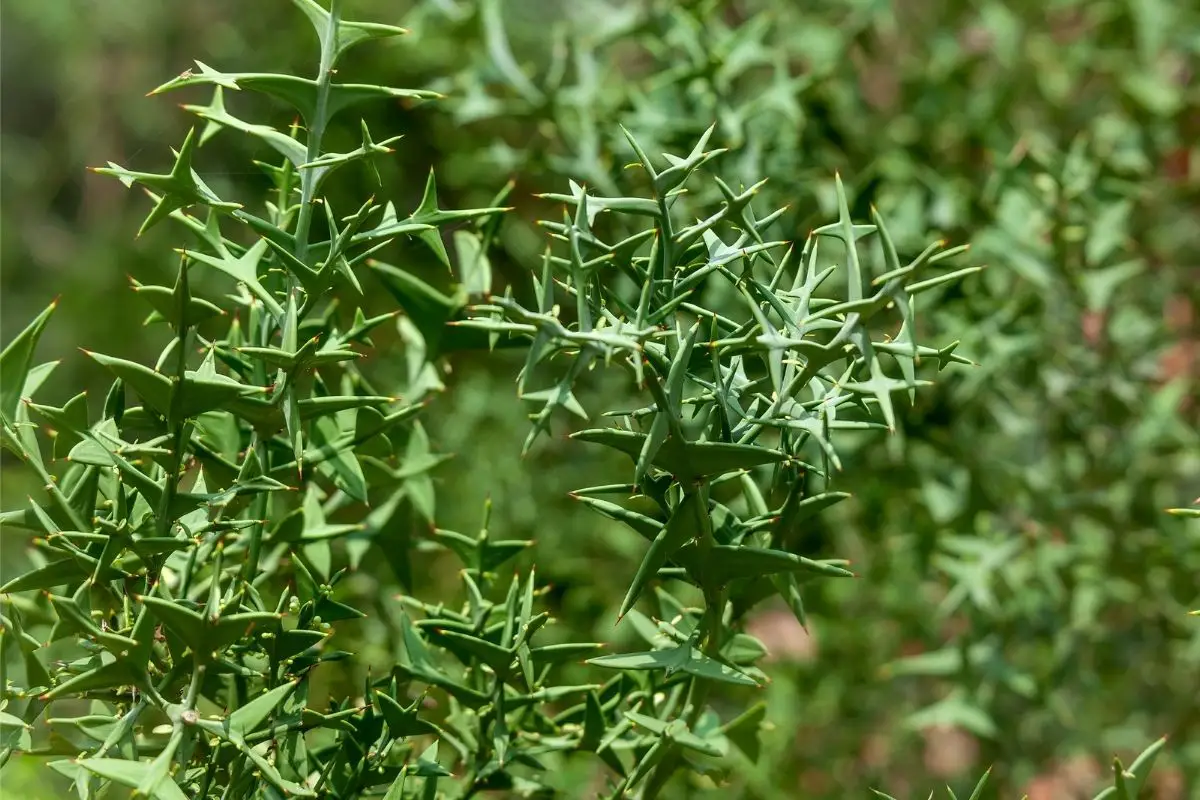Colletia is a genus of flowering shrubs with five, spiky species. Native to Southern parts of South America, this plant commonly grows in dry and rocky places.
Some species have a unique look and their appearance is relished by gardeners seeking out an out-of-the-ordinary, architectural plant.
These shrubs have a distinct, and unusual succulent-like appearance. C. paradoxa is, despite its appearance, a leafless plant.
What appear to be leaves are, in fact, the flattened stems of the plant. These stems act as leaves and are shaped like airplane propellers, leading to the species’ alternative name of the Jet Plane plant.
History
The genus was named by an 18th-century naturalist, in honor of a renowned French botanist from the 1600s, named Philibert Collet.
Plant Facts
| Scientific name | Colletia |
| Common names | Colletia |
| Genus | Colletia |
| Family | Rhamnaceae |
| Height | 10 feet (3m) |
| Width | 10 feet (3 m) |
| USDA Plant Hardiness Zone | Zones 8 to 11 |
| Native to | South, Southern America |
| Blooming season | Summer |
| Flower colors | White |
| Plant specific features | Sharp spines |
How to Plant and Grow a Colletia Bush
Where to Plant
All species have spines, and Colletia paradoxa is also known as Thorn of the Cross, or Crucifixion thorn because of its impenetrable center.
Colletia will deter people and animals, but care should be taken when planting in gardens if there are children or domestic animals likely to come into contact.
When to Plant
You can plant colletia during most of the year, apart from when the ground is too cold in the winter. However, the best time is probably autumn, as it will be easier to ensure that the plant doesn’t dry out during its first season.
If you plant in spring, the shrub will benefit from the warmer and longer days but you will need to keep an eye on the watering.
Colletia Shrubs Care and Maintenance
Soil
Colletia prefers soil that is fertile. It needs to drain well as the plant will rot if left sitting in soggy soil. The pH level of the soil is not unduly important.
Water
Colletia is a useful addition to a xeriscaping scheme as when it is established, it tolerates drought.
Fertilizer
Fertilizing colletia is not essential. However, you can help small plants or seedlings that have reached about 2 inches tall.
Use a nitrogen-rich, organic fertilizer that can be diluted in water. This will give the plant a quick boost which will encourage foliage growth but do not overdose.
Sunlight
Colletia likes full sun, so the best position is either a south or west-facing spot.
Pruning and Repotting
Before even considering how to prune your colletia, make sure you protect yourself from its sharp spikes.
Sometimes, the tips of the anchor plant can become damaged by frost. This is not a problem, you can simply cut them off.
These plants don’t really have any pruning requirements, but you will find that if you prune the shrub, it will encourage new growth and keep it a good, dense, and bushy shape.
Propagating
If you are planning on growing Colletia from seed, then be prepared for the long haul! These are not easy plants to grow from seed; the seed is difficult to germinate and very slow.
Before you even consider propagating colletia, make sure you have a very thick pair of gloves – you will need them!
A better option than sowing seeds is to take cuttings to overwinter. You can remove side shoots in late summer. Once again, this is a slow process but more reliable than growing from seed.
It can take up to two years for your cuttings to develop small roots, during which time you must ensure the pots don’t dry out. You can transplant the Colletia seedlings when the cutting has grown an established network of roots.
Pests and diseases
Once established, colletia are deer tolerant – probably due to their spiky thorns!
Temperature and Humidity
Colletia are tropical to sub-tropical plants. They are cold hardy to about -5° C but in a cooler region, you need to protect their roots with a thick mulch for the winter. It is also advisable to protect the top growth too.
Other Uses for Colletia
Colletia is a nitrogen-fixing shrub, converting nitrogen found in the air into a form that the shrub can use. It is because of this characteristic that colletia will thrive in low-quality soil.
It grows in very dry ground and its thorny spines provide it with protection against grazing animals.
Types of Colletia You Can Grow
The most well-known species is known as Colletia paradoxa, syn. Colletia cruciata or the Anchor plant, Jet plane plant, or Crucifixion thorn plant. This is a vicious little shrub! It has almost no visible leaves, just flattened stems that serve as leaves for the plant’s growth.
In its native habitat in Southern South America, this species is on the endangered list and threatened by extinction.
Because it is extremely slow growing, it usually doesn’t exceed 10 feet (3 m) in height in cultivation. This makes it an excellent choice for an unusual garden plant with architectural interest. It needs planting in a sheltered spot, away from the wind and in full sun.
Colletia spinosissima rosea produces white bell-shaped flowers twice a year and prefers a sunny situation. It is laden with the very sharp spines of the other colletia varieties, making it very prickly, if touched or handled.
Its flowers in the summer are strongly scented – a cross between the fragrance of honey and marzipan.
Conclusion
Colletia is a rare plant and not one you will find widely available. But for a touch of the unusual, if you can mimic its native growing conditions, then why not give it a go? Just buy a pair of gauntlets first!
*image by geniuslady/depositphotos

